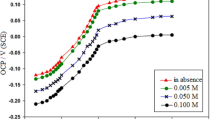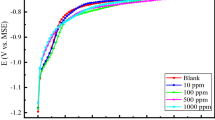Abstract
A comparative study on the corrosion effect of dental alloys in the presence of natural and commercial forms of orange extracts at various human body temperatures in the oral medium is reported for the first time. Three titanium alloys, namely Ni–Ti, Pure Titanium, and Ti-6Al-4V were examined, and corrosion studies, such as Gravimetric analysis, Potentiodynamic polarization, and Electrochemical Impedance spectroscopy, were carried out. The Tafel and Nyquist plots revealed that the inhibitor showed mixed and anodic-type characteristics. A high polarization resistance of 5.51 × 105 Ω cm2 was recorded by Ni–Ti alloy at high body temperature with an overall corrosion rate of 0.0147. The formed oxide layer was then studied using UV–visible spectroscopy, FTIR, X-ray Diffraction, and Scanning electron Microscope. The UV and FTIR peaks ensure the formation of inhibitor coating, and SEM images clearly show the formed layer's nature, proving the adsorption with evidence. Furthermore, the study indicates that acidic extract in a neutral medium affects the implant alloy's nature. Therefore, Nitinol is considered a suitable implant material even at an elevated temperature.










Similar content being viewed by others
Data Availability
The data sets used and analyzed during the current study are available from the corresponding author upon reasonable request.
Abbreviations
- CR:
-
Corrosion rate
- IE:
-
Inhibition efficiency
- Icorr :
-
Corrosion current
- LPR:
-
Linear polarization resistance
- ba:
-
Anodic Tafel slope
- bc:
-
Cathodic Tafel slope
- f max :
-
Maximum frequency
- Rct :
-
Charge transfer resistance
- Cdl :
-
Double layer capacitance
- Z′:
-
Real part
- Zʺ:
-
Imaginary part
References
Nagay BE, Cordeiro JM, Barao VA (2022) Insight into corrosion of dental implants: from biochemical mechanisms to designing corrosion-resistant materials. Current Oral Health Reports 9(2):7–21
Kamrani S, Fleck C (2019) Biodegradable magnesium alloys as temporary orthopedic implants: a review. Biometals 32:185
Prakasam M, Locs J, Salma-Ancane K, Loca D, Largeteau A, Berzina-Cimdina L (2017) Biodegradable materials and metallic implants—a review. Journal of functional biomaterials 8(4):44
Sumayli, A. (2021). Recent trends on bioimplant materials: A review. Materials Today: Proceedings, p. 46.
Ahirwar H, Zhou Y, Mahapatra C, Ramakrishna S, Kumar P, Nanda HS (2020) Materials for orthopedic bioimplants: modulating degradation and surface modification using integrated nanomaterials. Coatings 10(3):264
Souza JC, Apaza-Bedoya K, Benfatti CA, Silva FS, Henriques B (2020) A comprehensive review of the corrosion pathways of titanium dental implants and their biological adverse effects. Metals 10(9):1272
Abreu-García A, Souto RM, Izquierdo J (2023) Corrosion performance of Ti6Al7Nb alloy in simulated body fluid for implant application characterized using macro-and microelectrochemical techniques. Coatings 13(6):1121
Nicholson W, J. (2020) Titanium alloys for dental implants: A review. Prosthesis 2(2):100
Tahmasbi, S., Ghorbani, M., Sheikh, T., and Yaghoubnejad, Y. (2014). Galvanic Corrosion and Ion Release from Different Orthodontic Brackets and Wires in Acidic Artificial Saliva. Journal of Dental School, Shahid Beheshti University of Medical Sciences, 32(1).
Jiang JU, Li JJ, Jiang M, Li MY, Yang LX, Wang KM, Jun WANG (2021) Microstructure and electrochemical corrosion behavior of selective laser melted Ti− 6Al− 4V alloy in simulated artificial saliva. Transactions of Nonferrous Metals Society of China 31(1):167–177
Hosoki M, Nishigawa K, Miyamoto Y, Ohe G, Matsuka Y (2016) Allergic contact dermatitis caused by titanium screws and dental implants. J Prosthodont Res 60(3):213
Souza JC, Apaza-Bedoya K, Benfatti CA, Silva FS, Henriques B (2020) A comprehensive review on the corrosion pathways of titanium dental implants and their biological adverse effects. Metals 10(9):1272
Altay MA, Sindel A, Özalp Ö, Yıldırımyan N, Kocabalkan B (2019) Proton pump inhibitor intake negatively affects the osseointegration of dental implants: a retrospective study. J Korean Assoc Oral Maxillofac Surg 45(3):135
Přikrylová J, Procházková J, Podzimek Š (2019) Side effects of dental metal implants: impact on human health (metal as a risk factor of implantologic treatment). Biomed Res Int 2019:1
Bhola R, Bhola SM, Mishra B, Olson DL (2011) Corrosion in titanium dental implants/prostheses–a review. Trends Biomater Artif Organs 25(1):34–46
Palma Carrió, C., Maestre Ferrín, L., Peñarrocha Oltra, D., Peñarrocha Diago, M., and Peñarrocha Diago, M. (2011). Risk factors associated with early failure of dental implants. A literature review.
Dutta SR, Passi D, Singh P, Atri M, Mohan S, Sharma A (2020) Risks and complications associated with dental implant failure: Critical update. National Journal of Maxillofacial Surgery 11(1):14
Bazli L, Chahardehi AM, Arsad H, Malekpouri B, Jazi MA, Azizabadi N (2020) Factors influencing the failure of dental implants: A Systematic Review. Journal of Composites and Compounds 2(2):18
Naseri R, Yaghini J, Feizi A (2020) Levels of smoking and dental implants failure: A systematic review and meta-analysis. J Clin Periodontol 47(4):518
Do TA, Le HS, Shen YW, Huang HL, Fuh LJ (2020) Risk factors related to late failure of dental implant—A systematic review of recent studies. Int J Environ Res Public Health 17(11):3931
Dahiya S, Lata S, Kumar P, Kumar R (2016) A descriptive study for corrosion control of low-alloy steel by Aloe vera extract in acidic medium. Corros Rev 34(4):241–248
Yadav DK, Quraishi MA (2012) Application of some condensed uracils as corrosion inhibitors for mild steel: gravimetric, electrochemical, surface morphological, UV–visible, and theoretical investigations. Ind Eng Chem Res 51(46):14966–14979
Thayer TA, Bagby MD, Moore RN, DeAngelis RJ (1995) X-ray diffraction of Nitinol orthodontic arch wires. Am J Orthod Dentofac Orthop 107(6):604–612
Močnik P, Kosec T (2021) A critical appraisal of the use and properties of nickel–titanium dental alloys. Materials 14(24):7859
Espinoza-Montero PJ, Montero-Jiménez M, Fernández L, Paz JL, Piñeiros JL, Ceballos SM (2022) In vitro wearing away of orthodontic brackets and wires in different conditions: A review. Heliyon 8(9):e10560
Joany, R. M., Anandan, A., Gowri, S., Rajendran, S., Chugh, B., Kumaran, S. S., and Singh, G. (2020). Corrosion resistance of orthodontic wires in artificial saliva with presence of fragrant drink additives. In Nanotechnology in the Beverage Industry, Elsevier, 505-523.
Rajendran S, Paulraj J, Rengan P, Jeyasundari J, Manivannan M (2009) Corrosion behavior of metals in artificial saliva in presence of spirulina powder. Journal of Dentistry and Oral Hygiene 1(1):1–8
Rajendran S, Chitradevi P, Johnmary S, Krishnaveni A, Kanchana S, Christy L, Narayanasamy B (2010) Corrosion behaviour of SS 316 L in artificial saliva in presence of electral. Zaštita Materijala 51(3):149–158
Rajendran S, Uma V, Krishnaveni A, Jeyasundari J, Shyamaladevi B, Manivannan M (2009) Corrosion behavior of metals in artificial saliva in presence of D-Glucose. Arab J Sci Eng 34(2):147
D’Souza R, Chattree A, Rajendran S (2017) Corrosion resistance of an SS 316L alloy in artificial saliva in presence of a sparkle fresh toothpaste. Port Electrochim Acta 35(6):339
Mary, A. C. C., Jeyasundari, J., Banu, V. N., Dorothy, R., Rajendran, S., Kumaran, S. S., and Regis, A. P. P. (2020). Corrosion behavior of orthodontic wires in artificial saliva with presence of beverage. In Nanotechnology in the Beverage Industry Elsevier.
Acknowledgements
The authors thank the Department of Chemistry and Loyola Institute of Frontier Energy, Loyola College, Chennai 600 034 for their help and support.
Funding
The authors did not receive financial support from any institution.
Author information
Authors and Affiliations
Contributions
DD and AA conducted the study, and AK calculated the interpretations. The entire research was supervised, and the drats were corrected by JMS. All authors read and approved the final manuscript.
Corresponding author
Ethics declarations
Conflicts of Interest
The authors state no conflicts of interest.
Consent for Publication
Not applicable.
Rights and permissions
Springer Nature or its licensor (e.g. a society or other partner) holds exclusive rights to this article under a publishing agreement with the author(s) or other rightsholder(s); author self-archiving of the accepted manuscript version of this article is solely governed by the terms of such publishing agreement and applicable law.
About this article
Cite this article
Devadoss, D., Asirvatham, A., Kujur, A. et al. Electrochemical Behaviour of Dental Alloys in the Presence of Orange Extracts at Different Body Temperatures and Analysis of the Adsorbed Layer. Chemistry Africa 7, 2221–2234 (2024). https://doi.org/10.1007/s42250-023-00858-2
Received:
Accepted:
Published:
Issue Date:
DOI: https://doi.org/10.1007/s42250-023-00858-2




